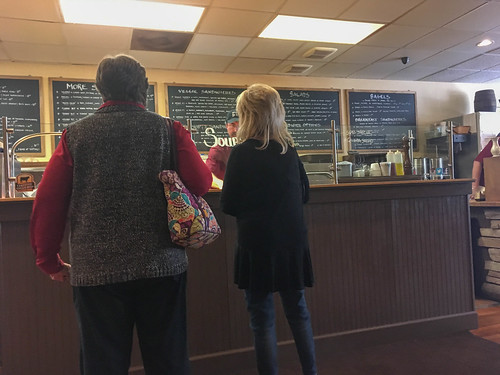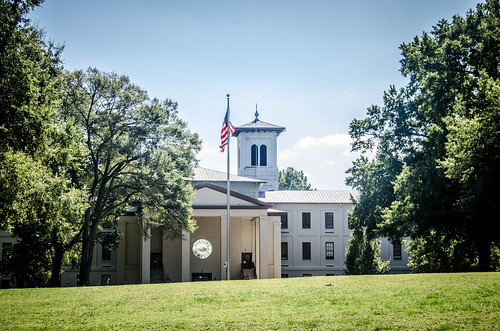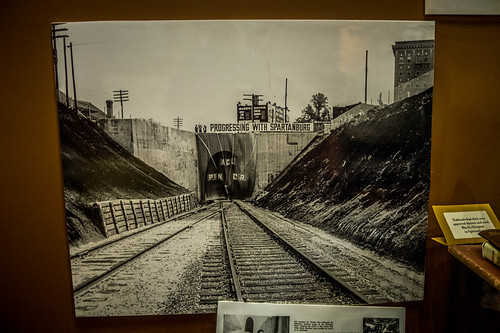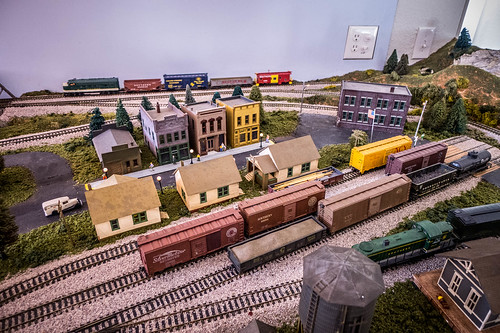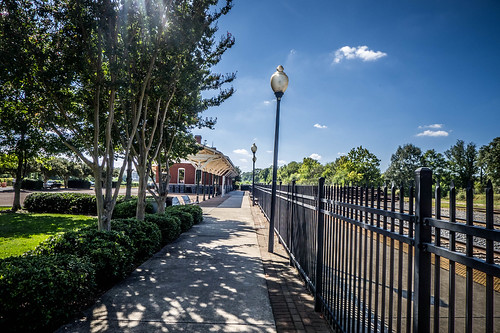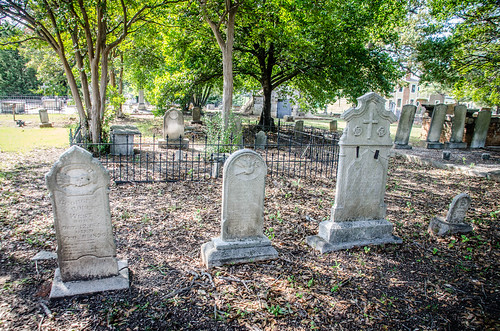I was out and about searching for examples of buildings designed by 19th century architect Edward C. Jones. I had visited three locations in Henderson County, including the Mansouri Inn, St. John in the Wilderness, and Calvary Episcopal. It was now time to close the loop and head back to South Carolina. I only had one more target related to Edward Jones, but I was far from done with explorations.
I finished up at Calvary Episcopal and even though it was a bit early, I was ready for some lunch. It was cooler than I expected and I had on the wrong attire – shorts, sandals, and a light shirt. Warm soup and a sandwich sounded quite appealing.
I drove back down US 25 to Hendersonville, found a place to park on Main Street, and walked along until I found a suitable spot. I haven’t done a restaurant review in awhile, and almost turned this section into a separate post, but just decided to include it in the trek report.
Mountain Deli
Mountain Deli looked like a good spot, so I walked on in. At first I was overwhelmed with choices. That’s the problem when you order at the counter. If you’re not a regular and know the options, it can be daunting.
When in a new place I always look for the specials. They had a carving board set up with a pork tenderloin wrapped in pork belly. The specialty sandwich for the day was this served on a Kaiser roll with an apple slaw.
Sounded good to me, so I ordered one with the soup of the day, Manhattan-styled clam chowder.
The sandwich was delicious, but wasn’t exactly what I expected. There was more sweet than salt, especially with the apple slaw, and the meat was more ham-like than roast-like. Regardless, I enjoyed it with the soup, which was salty. The pairing worked.
Suitably sated, I headed out for the next part of my trip. I took a quick turn through Hendersonville’s historic 7th street district. This is a row of buildings along the railroad that are undergoing revitalization. It reminds me of the 4th Street district in Tucson, AZ, when we lived there. I think just about every town has a section like this. Greenville’s analogous section would be the Pendleton Street section of West Greenville. Sadly, most of the buildings looked like they were still empty. I could see this being a great place for galleries, shops, and restaurants. OK, I’ll admit it. Sometimes gentrification has an appeal. At least the buildings would be in use rather than sitting and deteriorating.
I didn’t take any photos, but continued on my quest. For the first time this day I hit the interstate. I was driving a portion of I-26 I don’t normally drive, from Hendersonville to Spartanburg. Driving south one reaches spectacular views at Howard Gap out across the Piedmont. I was tempted to explore the Howard Gap Road, which had already caught my attention as a historical route, but decided to save that for another trek.
I drove on down through the northern sections of Spartanburg and realized that I actually know very little about this town so close to my own home city. All during my years in Spartanburg Five I felt like (and was somewhat treated like) an outsider. All of my coworkers’ points of reference were from Spartanburg, but mine were from Greenville.
Wofford Old Main
The next stop was a true Edward C. Jones shrine, Old Main at Wofford College. I turned one street too early and found myself at the back of the building.
I got myself oriented correctly and drove in front of the building. There were banners up everywhere for an upcoming homecoming, and lots of work being done on the building with lift trucks and other heavy-ish equipment. They were trying to spruce up the place, but I had to use some tricky camera angles to make sure the equipment didn’t get into the shots.
The twin towers are definitely Italianate, and are the spitting image of Furman’s tower (sans clock face.) However, these flank a portico that is more Greek Revival than Italianate, with its shallow pediment and stylized columns.
I had one more stop planned for the day. Magnolia Cemetery had been on my list to visit for quite some time. Since I was this close it made sense to head over there. Edward Jones designed Magnolia Cemetery in Charleston, but had nothing to do with this one, as far as I know. With people evacuating that city ahead of Hurricane Matthew, Magnolia Cemetery in Spartanburg would have to do. However, serendipity got in the way.
Hub City Railroad Museum
I made a couple of missteps, but soon found myself on Magnolia Street driving past the gates of the cemetery. Just south of the entrance were railroad tracks and an old depot. I thought this would be a good place to turn around and head back to the cemetery, now that I had found it. I also wanted a couple of photos of the old depot, which was in excellent repair.
A sign under the covered waiting area indicated that this was still an active passenger depot for Amtrak. Another sign proclaimed this as the home of the Hub City Railroad Museum.
By sheer luck I arrived on a day that the museum is open (Wednesday and Saturdays), but I got there about five minutes before they were scheduled to close. Volunteers Steven Ashley and Terry Berlesford were just getting ready to close shop. I said I’d just take a quick look around, since they were closing, but Terry graciously gave me a tour of the small museum.
The sheer number of artifacts crammed into a small space was almost overwhelming, but Terry’s running commentary helped me make sense of it. The displays gave understanding to how Spartanburg became known as the “Hub City.” Terry also talked about the politics of rail development, and the rivalry between Southern Railroad at its competitors. Southern was known for buying up land to prevent competitors from obtaining rights-of-way for their rails. It was a cutthroat business.
One of the coolest things Terry showed me was the ATCS Monitor they had set up in their entryway. This shows all active trains, and is perfect for trainspotters. Software is available for Windows, but Mac users like me are out of luck.
Terry had to close up the caboose that’s on the depot property and is part of the museum. He invited me to tag along and take a look. It was a surprising bright orange, and not the shade of red one normally expects.
Terry had told me earlier that many of the Southern Railroad cabooses were built right here in Spartanburg by Hayne Car Shops. The cabooses were built on a box car chassis, rather than a passenger car, so the ride was rather rough.
The interior of this caboose had been completely renovated. A HO scale railroad took up a large portion of the space. Terry fired it up and let it run for me.
Terry also pointed out some unique features of the depot yards. At one point the building was much more extensive, but the majority of it either burned or was demolished. A model in the museum showed the original building.
Only the utilitarian cargo end was spared, which would be the section to the right in the model above. That’s what now houses the museum and Amtrak station. However, you can still see the bricks and foundation of the former depot.
At one time this was a very active station. Terry told me that under the tracks was a subterranean waiting room so that passengers could get over to the westbound tracks. The room is still there, but has been filled in because it became a hangout for riffraff.
Now Amtrak only stops twice a day at ungodly hours like 4:00 am. You’ve got to either be desperate or really want to ride the train. It’s a shame, because a good rail system would be great for this area. I think that every time I drive I-85.
From my vantage point on the caboose I could look across the tracks to my final target for the day. It was time to move on. I thanked Terry for his tour and dropped a few dollars into their donation bin. Before leaving, though, a couple of things caught my eye. There was an old trestle that brought the train on this side of the depot. Half of it was covered with kudzu. The trestle crossed yet another railroad line, which appeared to be an industrial spur. There are several places in Spartanburg where railroads cross other railroads.
Magnolia Cemetery
I crossed the tracks and entered the gates to the small Magnolia Cemetery. Keith had warned me that the cemetery was in serious need of restoration, and I found that to be the case. There were lots of toppled stones and other disrepair.
I had one particular grave of interest to me, though. William “Singing Billy” Walker is buried here. Walker was the publisher of the Southern Harmony, a shape-note songbook used throughout the South. Walker was the brother-in-law of B. F. White, who published the competing Sacred Harp songbook.
Each year Wofford sponsors a William Walker Memorial Singing, in which participants sing from the Southern Harmony (and a bit from the Sacred Harp.) It is traditional for the group to end the singing by walking from Wofford to Walker’s grave in Magnolia and singing a few final songs. I’ve participated in the singing several times, but I never stuck around for the walk to Walker’s grave.
I found Walker’s grave at the end of the short dirt drive.
Having paid my respects, I checked out the rest of the cemetery. Despite the damage there was still some interesting funerary artwork.
There was also a mausoleum for the Hosea J. Dean Family which stood empty and open.
There were members of the Cleveland family, who donated the land for the cemetery and for whom Cleveland Park in Spartanburg is named. I also found one signature stone sitting precariously at the edge of the road.
The grave was for Rev. Henry Hill Durant, and was signed by “R. Hare Y. V.” I later learned that this was Robert Hare, a stone carver from Yorkville. I didn’t see any other signatures.
Even though Edward C. Jones had no association with THIS Magnolia Cemetery, there was one last grave that ties all of this back to my initial trek. Dr. James Henry Carlisle was president of Wofford at the time that Old Main was under construction. He surely would have met Jones. His headstone features Old Main prominently in bas relief.
I left Spartanburg and made my way home through hellacious I-85 traffic, thankful all the while that I don’t have to do this on a daily basis anymore.
One final word…I had been out searching for Edward Jones. Apparently he was looking for me, too. As a weird bit of irony, I found this hanging on my door when I got back from my trek.
Who knew? I could have stayed right here and chatted with him about his wonderful buildings.


